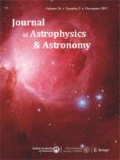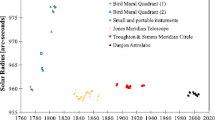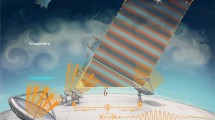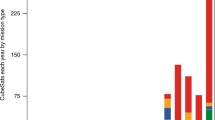Abstract
The PICARD microsatellite mission will provide 2 to 6 years simultaneous measurements of the solar diameter, differential rotation and solar constant to investigate the nature of their relations and variabilities. The 100 kg satellite has a 40 kg payload consisting of 3 instruments which will provide an absolute measure (better than 10 milliarcsec) of the diameter and the solar shape, a measure of total solar irradiance, and UV and visible flux in selected wavelength bands. Now in Phase B, PICARD is expected to be launched before mid-2003. The engineering model of the diameter telescope will be used on ground simultaneously with the satellite to investigate the atmospheric bias and state on the possible accuracy of the ground measurements carried up to now. We review the scientific goals linked to the diameter measurement, present the payload, and give a brief overview of the program aspects.
Similar content being viewed by others
References
Appourchaux, T.et al. 2000, Observational Upper Limits for Low-Degree Solar g-Modes,Ap. J., in press.
Appourchaux, T., Toutain, T. 1997, inSounding Solar and Stellar Interiors, SymposiumIAU, 181, (eds.) Janine Provost and Francois-Xavier Schmider, 5.
Dame, L., Hersé, M., Thuillier, G.et al. 1999, PICARD: Simultaneous Measurements of the Solar Diameter, Differential Rotation, Solar Constant and their Variations,Adv. in Space Research, 24(2), 205–214.
Fröhlich, C. the Phoebus Group 1998, inStructure and Dynamics of the Sun and Solar-like Stars (SOHO 6 /GONG 98),ESA SP-418, 67.
Kuhn, J. R., Bogart, R., Bush, R.et al. 1997, Precision Solar Astrometry from SOHO/MDI, inSounding Solar and Stellar Interiors, SymposiumIAU,181, (eds.) Janine Provost and Francois-Xavier Schmider, 103–110.
Laclare, F., Delmas, C., Coin, J. P., Irbah, A. 1996, Measurements and Variations of the Solar Diameter,Solar Physics,166, 211–229.
Lean, J. 1997, The Sun’s Variable Radiation and its Relevance for Earth,Annu. Rev. Astron. Astrophys.,35, 33–67.
Ribes, E., Ribes, J. C., Barthalot, R. 1987, Evidence for a Larger-Sun with a Slower Rotation during the Seventeenth Century,Nature,326, 52–55.
Sadourny, R. 1994, Sensitivity of Climate to Long-term Variations of the Solar Output, inThe solar engine and its influence on terrestrial atmosphere and climate, (ed.) E. Nesme-Ribes, (Springer Verlag),NATO ASI Series I,25, 479–491.
Author information
Authors and Affiliations
Rights and permissions
About this article
Cite this article
Damé, L. New high resolution observations of the solar diameter from space and ground with the microsatellite program PICARD. J Astrophys Astron 21, 135–140 (2000). https://doi.org/10.1007/BF02702378
Issue Date:
DOI: https://doi.org/10.1007/BF02702378




